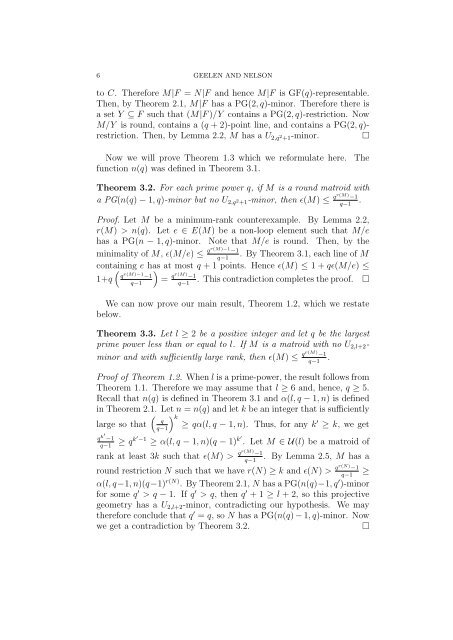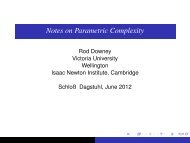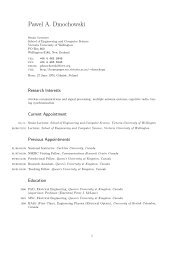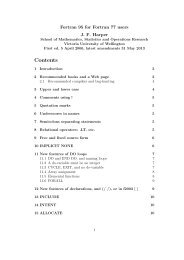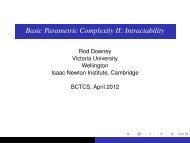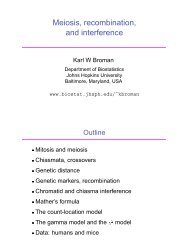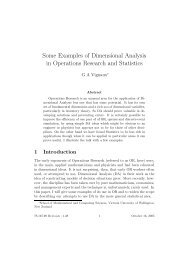The number of points in a matroid with no n-point line as a minor
The number of points in a matroid with no n-point line as a minor
The number of points in a matroid with no n-point line as a minor
You also want an ePaper? Increase the reach of your titles
YUMPU automatically turns print PDFs into web optimized ePapers that Google loves.
6 GEELEN AND NELSON<br />
to C. <strong>The</strong>refore M|F = N|F and hence M|F is GF(q)-representable.<br />
<strong>The</strong>n, by <strong>The</strong>orem 2.1, M|F h<strong>as</strong> a PG(2, q)-m<strong>in</strong>or. <strong>The</strong>refore there is<br />
a set Y ⊆ F such that (M|F )/Y conta<strong>in</strong>s a PG(2, q)-restriction. Now<br />
M/Y is round, conta<strong>in</strong>s a (q + 2)-po<strong>in</strong>t l<strong>in</strong>e, and conta<strong>in</strong>s a PG(2, q)restriction.<br />
<strong>The</strong>n, by Lemma 2.2, M h<strong>as</strong> a U 2,q 2 +1-m<strong>in</strong>or. <br />
Now we will prove <strong>The</strong>orem 1.3 which we reformulate here. <strong>The</strong><br />
function n(q) w<strong>as</strong> def<strong>in</strong>ed <strong>in</strong> <strong>The</strong>orem 3.1.<br />
<strong>The</strong>orem 3.2. For each prime power q, if M is a round <strong>matroid</strong> <strong>with</strong><br />
a PG(n(q) − 1, q)-m<strong>in</strong>or but <strong>no</strong> U 2,q 2 +1-m<strong>in</strong>or, then ɛ(M) ≤ qr(M) −1<br />
q−1 .<br />
Pro<strong>of</strong>. Let M be a m<strong>in</strong>imum-rank counterexample. By Lemma 2.2,<br />
r(M) > n(q). Let e ∈ E(M) be a <strong>no</strong>n-loop element such that M/e<br />
h<strong>as</strong> a PG(n − 1, q)-m<strong>in</strong>or. Note that M/e is round. <strong>The</strong>n, by the<br />
. By <strong>The</strong>orem 3.1, each l<strong>in</strong>e <strong>of</strong> M<br />
conta<strong>in</strong><strong>in</strong>g e h<strong>as</strong> at most q + 1 <strong>po<strong>in</strong>ts</strong>. Hence ɛ(M) ≤ 1 + qɛ(M/e) ≤<br />
qr(M)−1 −1<br />
1+q<br />
= q−1<br />
qr(M) −1<br />
. This contradiction completes the pro<strong>of</strong>. <br />
q−1<br />
m<strong>in</strong>imality <strong>of</strong> M, ɛ(M/e) ≤ qr(M)−1 −1<br />
q−1<br />
We can <strong>no</strong>w prove our ma<strong>in</strong> result, <strong>The</strong>orem 1.2, which we restate<br />
below.<br />
<strong>The</strong>orem 3.3. Let l ≥ 2 be a positive <strong>in</strong>teger and let q be the largest<br />
prime power less than or equal to l. If M is a <strong>matroid</strong> <strong>with</strong> <strong>no</strong> U2,l+2m<strong>in</strong>or<br />
and <strong>with</strong> sufficiently large rank, then ɛ(M) ≤ qr(M) −1<br />
q−1 .<br />
Pro<strong>of</strong> <strong>of</strong> <strong>The</strong>orem 1.2. When l is a prime-power, the result follows from<br />
<strong>The</strong>orem 1.1. <strong>The</strong>refore we may <strong>as</strong>sume that l ≥ 6 and, hence, q ≥ 5.<br />
Recall that n(q) is def<strong>in</strong>ed <strong>in</strong> <strong>The</strong>orem 3.1 and α(l, q − 1, n) is def<strong>in</strong>ed<br />
<strong>in</strong> <strong>The</strong>orem 2.1. Let n = n(q) and let k be an <strong>in</strong>teger that is sufficiently<br />
large so that<br />
k q<br />
q−1<br />
≥ qα(l, q − 1, n). Thus, for any k ′ ≥ k, we get<br />
qk′ −1<br />
q−1 ≥ qk′ −1 k ≥ α(l, q − 1, n)(q − 1) ′<br />
. Let M ∈ U(l) be a <strong>matroid</strong> <strong>of</strong><br />
rank at le<strong>as</strong>t 3k such that ɛ(M) > qr(M) −1<br />
. By Lemma 2.5, M h<strong>as</strong> a<br />
q−1<br />
round restriction N such that we have r(N) ≥ k and ɛ(N) > qr(N) −1<br />
q−1<br />
α(l, q−1, n)(q−1) r(N) . By <strong>The</strong>orem 2.1, N h<strong>as</strong> a PG(n(q)−1, q ′ )-m<strong>in</strong>or<br />
for some q ′ > q − 1. If q ′ > q, then q ′ + 1 ≥ l + 2, so this projective<br />
geometry h<strong>as</strong> a U2,l+2-m<strong>in</strong>or, contradict<strong>in</strong>g our hypothesis. We may<br />
therefore conclude that q ′ = q, so N h<strong>as</strong> a PG(n(q) − 1, q)-m<strong>in</strong>or. Now<br />
we get a contradiction by <strong>The</strong>orem 3.2. <br />
≥


